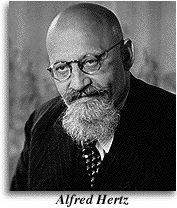 Alfred Hertz was the second conductor of
the San Francisco
Symphony, and replaced Henry Hadley, in 1915, when the orchestra was just four
years old. Hertz remained with the symphony until his farewell performance April 15, 1930.
Alfred Hertz was the second conductor of
the San Francisco
Symphony, and replaced Henry Hadley, in 1915, when the orchestra was just four
years old. Hertz remained with the symphony until his farewell performance April 15, 1930.
During that period he built a professional organization, and the orchestra began to record for Victor’s prestigious Red Seal label. The symphony recorded Mussorgsky’s Night on Bald Mountain for Victor during the late 1920s.
Hertz was no stranger to San Francisco, and was here during the Great Earthquake and Fire of 1906, conducting the orchestra for Enrico Caruso ’s Metropolitan Opera tour.
Hertz later described the earthquake as sounding “Something comparable to the mezzo forte roll on a cymbal or gong. ”
He returned to San Francisco, in 1915, to direct a series of Beethoven Festival performances and, while here, was offered leadership of the San Francisco Symphony.
During his tenure, wrote Elsa Melville in The Musical News, he was responsible for bringing the first women players into the San Francisco Symphony.
During the 1930s Hertz was actively involved in relief activities to assist musicians affected by the Depression, and was conductor of the Standard Symphony Hour on radio.
Hertz is today remembered for funding Hertz Hall at Berkeley, and for the Alfred Hertz Memorial Performance Fellowship awarded each year by UC.
Gladys Hansen — 1997
Until a few days ago he continued his musical work, although retired, as an orchestra leaders, writing accompaniments for German leider features in recitals by his wife, Lilly.
During his 40 years in this country he was acclaimed as an orchestra conductor and opera director. His American triumphs began in 1903, when he directed the first performance of Wagner’s “Parsifal” outside of Bayreuth, Germany, in the Metrapolitan Opera House, New York city.
And 11,000 persons applauded and cheered him in the Civic Auditorium here the night of April 15, 1930, when he made his farewell appearance as conductor of the San Francisco Symphony, which he had conducted for 15 years.
His bushy beard and twinkling eyes were known to music lovers in a score of cities where he had filled long engagements or conducted symphonies and operas on tours. Crippled since a childhood attack of infantile paralysis, he always walked with a cane, but briskly and cheerfully.
He was born July 15, 1872, at Frankfort-on-the-Main, began his musical education there. By 1899 his fame as a Wagnerian conductor had spread and he was engaged for concerts in London. He came to this city in 1902 and, until 1915, he was the Metropolitan’s director of German opera. He made several trips back to Europe for brief musical engagements.
Among his “firsts ” in this country in addition to “Parsifal ” were “Lonigskinder ” and Richard Strauss ’ “Salome ” as well as several American operas —
San Francisco News
April 17, 1942
![]()